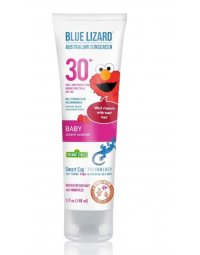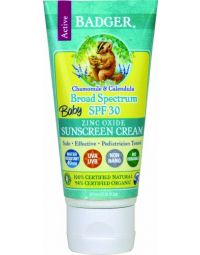Chemical sunscreens such as oxybenzone have lost popularity recently because of their damaging effects on coral reefs and potential health concerns for humans. Because of this, more sunscreen products now only contain the mineral UV filters zinc oxide and titanium dioxide. Of these two, zinc oxide provides the best health benefits for your skin.

”Zinc Oxide is more effective than titanium dioxide in regards to UVA protection” (NIH.gov)

How Zinc Oxide Protects Your Skin from the Sun
Zinc is an elemental metal found naturally in the environment. It can react with oxygen to form the mineral zinc oxide (ZnO). Small particles of zinc oxide are extremely effective at reflecting photons of light in the ultraviolet range. When incorporated into a lotion and spread across the skin, they form a protective layer that prevents UV radiation from getting through and damaging molecular structures in the skin.1 Since it reflects, not absorbs, UV light, zinc oxide is known as a physical or inorganic UV filter, and sunscreens that contain it are called physical, barrier, or mineral sunscreens.
Because of its efficacy at blocking UV rays, zinc oxide was one of the first sunscreen ingredients and remains popular to this day. Thousands of years ago, people started putting zinc oxide paste on their skin to protect themselves from the sun.2 More recently, researchers at the Jet Propulsion Laboratory developed UV protective glass made with zinc oxide particles that NASA uses in welding shields and sunglasses worn by astronauts exposed to intense UV radiation in space.3

Zinc Oxide Sunscreens Help Prevent Sunburn and Skin Cancer
There are two kinds of UV radiation that can cause skin damage: UVA and UVB. Most UV filters in commercial sunscreens protect well against UVB, but few protect fully against UVA. Zinc oxide is beneficial because it provides full protection against both these types of UV rays.4,5
In the short term, zinc oxide sunscreens are effective in preventing sunburns.6 Long-term, exposure to UV radiation can cause far more harm than sunburns. UV rays that penetrate skin cells can cause DNA damage and suppress immunity in the area, both of which consequences can give rise to skin cancers such as melanoma. By blocking both UVA and UVB rays, zinc oxide likewise helps to prevent skin cancer from sun exposure.6,7 It also helps reduce visual signs of aging in your skin, like wrinkles and age spots, if used consistently.7

Non-Nanomized Zinc Oxide is Safe for Humans and for Coral
The concentrations of zinc oxide contained in commercially-available sunscreens, both lotion and spray-on, are well within the safe exposure level for humans.8 Animal studies have also found on multiple occasions that long-term use of sunscreens that contain zinc oxide does not cause harmful effects.9,10
Compared to chemical UV filters such as oxybenzone and octinoxate, inorganic UV filters like zinc oxide do not cause the same amount of damage to coral reefs.11 However, many sunscreen brands have begun using zinc oxide nanoparticles to reduce their chalky white appearance. These are small enough to be absorbed by cells. Zinc oxide nanoparticles (less than 100 nanometers in diameter) can be toxic to corals and may even cause oxidative damage to human cells.12 Look for sunscreens that contain non-nanomized zinc oxide, which has particle sizes of 100 nanometers or greater and are too large to enter cells.

Zinc is Good for Your Skin
Zinc is an essential nutrient for skin health. Because of this, it is added to many cosmetic products and topical products to treat skin conditions. Zinc oxide is an ingredient in baby powder to treat incontinence-associated dermatitis (diaper rash)13 and in calamine lotion to treat mild itching.14 It is also useful in healing ulcers15 and warts,16 and can prevent bacterial infections in wounds.17 Overall, zinc oxide is a healthy ingredient to be using on your skin.


Best Zinc Oxide Sunscreens
Below are some of the top brands of non-nanomized zinc oxide sunscreens for UV protection, coral reef safety, and personal health.
[1] Schneider SL, Lim HW. 2018. “A review of inorganic UV filters zinc oxide and titanium dioxide.” Photodermatol Photoimmunol Photomed. Nov 16; [Epub] doi: 10.1111/phpp.12439. https://www.ncbi.nlm.nih.gov/pubmed/30444533
[2] Craddock PT. 1990. “2000 Years of Zinc and Brass.” Occasional Paper, issue 50. British Museum. https://books.google.com/books/about/2000_Years_of_Zinc_and_Brass.html?id=3dTbAAAAMAAJ
[3] National Aeronautics and Space Administration. December 1, 2010. “Ultraviolet-Blocking Lenses Protect, Enhance Vision.” NASA Technical Reports Server. https://ntrs.nasa.gov/archive/nasa/casi.ntrs.nasa.gov/20110000736.pdf
[4] Environmental Protection Agency. “Sunscreen: The Burning Facts.” EPA 430-F-06-013, September 2016. https://www.epa.gov/sites/production/files/documents/sunscreen.pdf
[5] Beasley DG, Meyer TA. 2010. “Characterization of the UVA protection provided by avobenzone, zinc oxide, and titanium dioxide in broad-spectrum sunscreen products.” Am J Clin Dermatol. Dec 1; 11(6):413-421. https://www.ncbi.nlm.nih.gov/pubmed/20806994
[6] van der Molen RG, Hurks HM, Out-Luiting C, Spies F, van't Noordende JM, Koerten HK, Mommaas AM. 1998. “Efficacy of micronized titanium dioxide-containing compounds in protection against UVB-induced immunosuppression in humans in vivo.” J Photochem Photobiol B. Jul 10; 44(2):143-150. https://www.ncbi.nlm.nih.gov/pubmed/9757596?dopt=Abstract
[7] Gonzaga ER. 2009. “Role of UV light in photodamage, skin aging, and skin cancer: importance of photoprotection.” Am J Clin Dermatol. 10(Suppl 1):19-24. https://www.ncbi.nlm.nih.gov/pubmed/19209950
[8] Kim KB, Kim YW, Lim SK, Roh TH, Bang DY, Choi SM, Lim DS, Kim YJ, Baek SH, Kim MK, Seo HS, Kim MH, Kim HS, Lee JY, Kacew S, Lee BM. 2017. “Risk assessment of zinc oxide, a cosmetic ingredient used as a UV filter of sunscreens.” J Toxicol Environ Health B Crit Rev. 20(3):155-182. https://www.ncbi.nlm.nih.gov/pubmed/28509652
[9] Ryu HJ, Seo MY, Jung SK, Maeng EH, Lee SY, Jang DH, Lee TJ, Jo KY, Kim YR, Cho KB, Kim MK, Lee BJ, Son SW. 2014. “Zinc oxide nanoparticles: a 90-day repeated-dose dermal toxicity study in rats.” Int J Nanomedicine. Dec 15; 9(Suppl 2):137-144. https://www.ncbi.nlm.nih.gov/pubmed/25565832
[10] Osmond-McLeod MJ, Oytam Y, Rowe A, Sobhanmanesh F, Greenoak G, Kirby J, McInnes EF, McCall MJ. 2016. “Long-term exposure to commercially available sunscreens containing nanoparticles of TiO2 and ZnO revealed no biological impact in a hairless mouse model.” Part Fibre Toxicol. Aug 17; 13(1):44. https://www.ncbi.nlm.nih.gov/pubmed/27534937
[11] Environmental Wellness Group. 2018. “12th Annual EWG Sunscreen Guide.” https://www.ewg.org/sunscreen/report/executive-summary/
[12] Hou J, Wu Y, Li X, Wei B, Li S, Wang X. 2018. “Toxic effects of different types of zinc oxide nanoparticles on algae, plants, invertebrates, vertebrates and microorganisms.” Chemosphere. Feb; 193:852-860. https://www.ncbi.nlm.nih.gov/pubmed/29874759
[13] Panther P, Hines S, Kynoch K, Coyer F. 2017. “Effectiveness of topical skin products in the treatment and prevention of incontinence-associated dermatitis: a systematic review.” JBI Database System Rev Implement Rep. May; 15(5):1473-1496. https://www.ncbi.nlm.nih.gov/pubmed/28498177
[14] Gupta M, Mahajan VK, Mehta KS, Chauhan PS. 2014. “Zinc therapy in dermatology: a review.” Dermatol Res Pract. 2014:709152. https://www.ncbi.nlm.nih.gov/pubmed/25120566
[15] Lansdown AB, Mirastschijski U, Stubbs N, Scanlon E, Agren MS. 2007. “Zinc in wound healing: theoretical, experimental, and clinical aspects.” Wound Repair Regen. Jan-Feb; 15(1):2-16. https://www.ncbi.nlm.nih.gov/pubmed/17244314
[16] Khattar JA, Musharrafieh UM, Tamim H, Hamadeh GN. 2007. “Topical zinc oxide vs. salicylic acid-lactic acid combination in the treatment of warts.” Int J Dermatol. Apr; 46(4):427-430. https://www.ncbi.nlm.nih.gov/pubmed/17442091
[17] Pati R, Mehta RK, Mohanty S, Padhi A, Sengupta M, Vaseeharan B, Goswami C, Sonawane A. 2014. “Topical application of zinc oxide nanoparticles reduces bacterial skin infection in mice and exhibits antibacterial activity by inducing oxidative stress response and cell membrane disintegration in macrophages.” Nanomedicine. Aug; 10(6):1195-1208. https://www.ncbi.nlm.nih.gov/pubmed/24607937
-
Sunscreen vs Sunblock
By Dr. AnnaDecember 20, 2021 -
Pregnancy-Safe Sunscreens
By Dr. AnnaDecember 20, 2021 -
Physical vs Chemical Sunscreens
By Dr. KarenDecember 26, 2021 -
Reef Safe Sunscreens
By Dr. KarenDecember 21, 2021 -
Best Baby Sunscreen
By Dr. AnnaDecember 17, 2021




Search the blog
Article Categories
- All Articles (95)
- Rating Charts (1)
- Beauty & Skincare (17)
- FAQ (0)
- Hair Care (9)
- Health & Wellness (12)
- Anti-Aging (4)
- Kid's Health (0)
- Makeup (2)
- Men's Health (2)
- Oral Care (3)
- Sunscreen (7)
- Skin Tools & Treatments (10)
- Supplements (26)
- Videos (0)
















